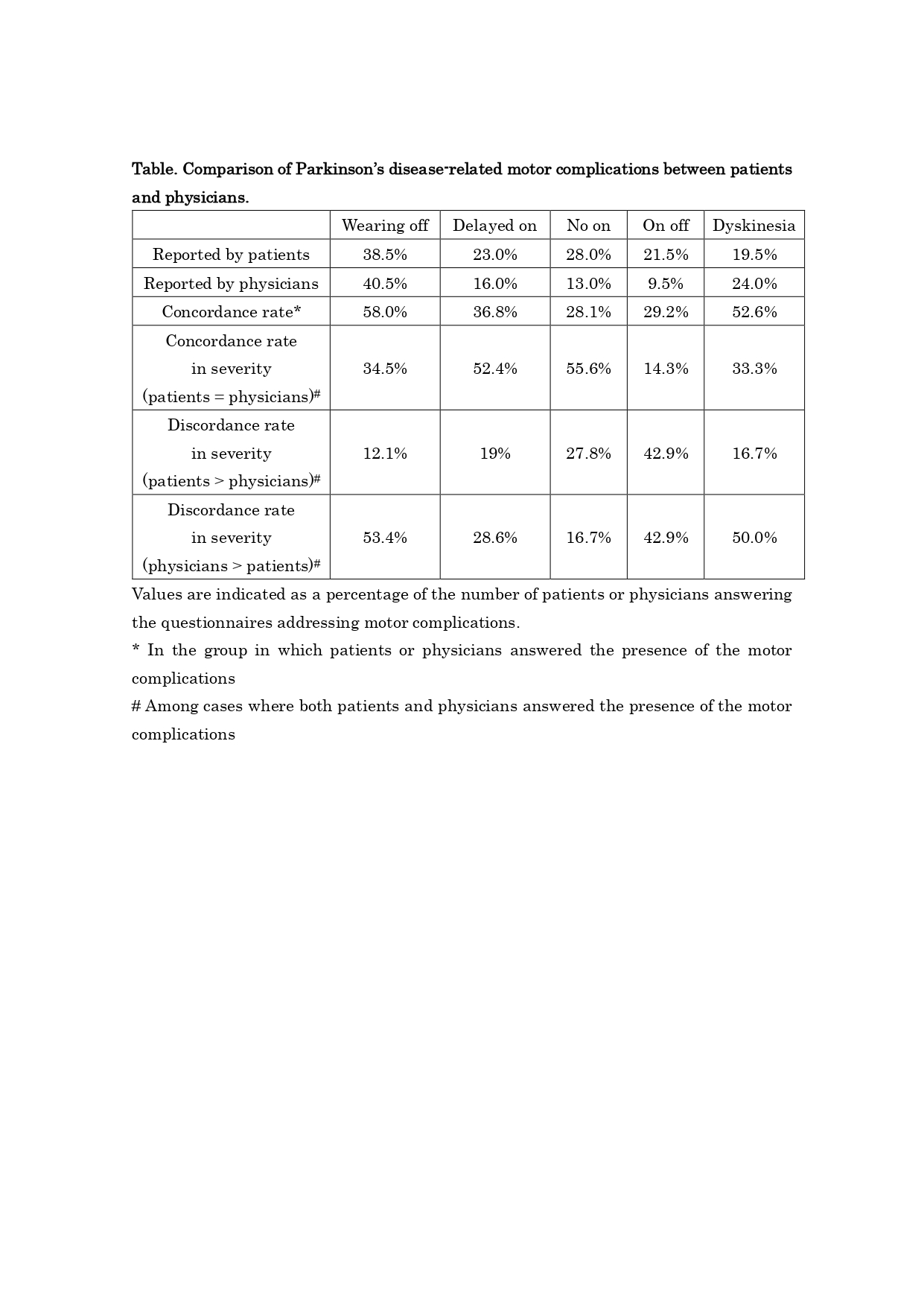Category: Parkinsonism, Others
Objective: This study aimed to evaluate the differences in the perception of Parkinson’s disease (PD)-related motor complications by utilizing questionnaires answered by both PD patients and their attending physicians.
Background: Motor complications such as wearing-off (WO) phenomenon significantly diminish the quality of life in PD patients and can be challenging for patients to identify without the understanding of motor fluctuations. We investigated disparities in the perception of motor complications between PD patients and their attending physicians.
Method: Questionnaire addressing motor complications in PD were administered to both patients and their attending physicians, respectively. The presence and severity of motor complications (WO, delayed on (DO), no on (NO), on off (OF) phenomenon and dyskinesia (Dys)) as perceived by patients or physicians were evaluated. By comparing the perceived severity of motor complications between patients and physicians, we identified the concordance and discordance in the perception.
Results: Two hundred PD patients (male 113, age 72.3±8.8 years, Hoehn Yahr stage 2.9±0.8, disease duration 9.0±5.8 years) were recruited. The frequency of WO, DO, NO, OF phenomenon and Dys reported by PD patients was 38.5%, 23.0%, 28.0%, 21.5%, and 19.5%, respectively. Correspondingly, the frequency of WO, DO, NO, OF phenomenon and Dys reported by physicians was 40.5%, 16.0%, 13.0%, 9.5%, or 24.0%, respectively. In the group in which patients or physicians answered the presence of motor complications, the concordance rates for the perception of WO, DO, NO, OF phenomenon and Dys between patients and physicians was 58.0%, 36.8%, 28.1%, 29.2%, or 52.6%, respectively. Among cases where both patients and physicians answered the presence of motor complications, physicians perceived WO, DO, NO, OF phenomenon, and Dys as more severe than patients in 53.4%, 28.6%, 16.7%, 42.9%, or 50.0%, respectively.
Conclusion: According to our questionnaires answered by both PD patients and their physicians, WO phenomenon and Dys tend to be more commonly perceived by both patients and physicians compared to the other motor complications. Additionally, physicians tend to perceive WO phenomenon and Dys more severe than patients. It is important to notice these disparities in order to improve the treatment for PD-related motor complications.
Abstract Table
References: [1] Politis M, Wu K, Molloy S, G Bain P, Chaudhuri KR, Piccini P. Parkinson’s disease symptoms: the patient’s perspective. Mov Disord. 2010 Aug 15;25(11):1646-51.
[2] Hashimoto M, Manabe Y, Yamaguchi T, Toya S, Ikeda M. Treatment needs of dementia with Lewy bodies according to patients, caregivers, and physicians: a cross-sectional, observational, questionnaire-based study in Japan. Alzheimers Res Ther. 2022 Dec 15;14(1):188.
To cite this abstract in AMA style:
T. Tezuka, R. Okochi, Y. Sakai, T. Nukariya, S. Okusa, Y. Nihei, J. Nakahara, M. Seki. The Differences in the Perception of Parkinson’s Disease-related Motor Complications between Patients and Physicians [abstract]. Mov Disord. 2024; 39 (suppl 1). https://www.mdsabstracts.org/abstract/the-differences-in-the-perception-of-parkinsons-disease-related-motor-complications-between-patients-and-physicians/. Accessed December 6, 2025.« Back to 2024 International Congress
MDS Abstracts - https://www.mdsabstracts.org/abstract/the-differences-in-the-perception-of-parkinsons-disease-related-motor-complications-between-patients-and-physicians/

